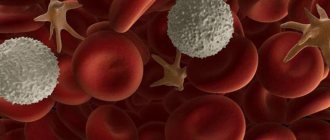What is multiple myeloma?
This is a tumor disease that arises from blood plasma cells (a subtype of leukocytes, i.e. white blood cells). In a healthy person, these cells participate in immune defense processes by producing antibodies. In multiple myeloma (also called myeloma), altered plasma cells accumulate in the bone marrow and bones, which disrupts the formation of normal blood cells and the structure of bone tissue. Sometimes you can hear about bone myeloma, myeloma of the spine, kidneys or blood, but these are not entirely correct names. Multiple myeloma already implies damage to the hematopoietic system and bones.
Prevention and recommendations
Multiple myeloma is unpredictable and insidious. Therefore, there is no special prevention. There are studies that show a correlation between a healthy and active lifestyle in old age and a reduced risk of disease. In the initial stages of the disease, patients are advised to adhere to certain nutritional rules, namely:
- Eliminate canned food and processed foods from your diet.
- Increase the amount of foods rich in iron - bell peppers, red meat, broccoli, papaya, mango.
- Include more fruits and vegetables in your diet.
- Reduce your intake of protein foods, including milk and dairy products, eggs, beans, and nuts.
There are studies about the beneficial effects of the oriental spice turmeric. The antioxidant curcumin it contains has anti-inflammatory properties and helps slow down the growth of tumor cells, and also prevents resistance to chemotherapy drugs.
Classification of myeloma
The disease is heterogeneous, the following options can be distinguished:
- monoclonal gammopathy of unknown origin is a group of diseases in which an excessive number of B-lymphocytes (these are blood cells that participate in immune reactions) of one type (clone) produce abnormal immunoglobulins of different classes, which accumulate in different organs and disrupt their function (very often kidneys suffer).
- lymphoplasmacytic lymphoma (or non-Hodgkin's lymphoma), in which a very large amount of synthesized class M immunoglobulins damages the liver, spleen, and lymph nodes.
- There are two types of plasmacytoma: isolated (affects only the bone marrow and bones) and extramedullary (plasmacytoma accumulates in soft tissues, such as the tonsils or sinuses). Isolated bone plasmacytoma sometimes progresses to multiple myeloma, but not always.
- Multiple myeloma accounts for up to 90% of all cases and usually affects multiple organs.
Also distinguished:
- asymptomatic (smoldering, asymptomatic myeloma)
- myeloma with anemia, kidney or bone damage, i.e. with symptoms.
Myeloma code according to ICD-10: C90.
Causes affecting the disease
In medicine, the disease is also referred to as generalized plasmacytoma, myeloblastoma, or plasma cell myeloma. In simple terms, it is a cancer of plasma cells located in the bone marrow. Pathological signs may not be detected for a long time and appear only at 2-3 degrees. Doctors are still working to determine the true causes of cancer. The following factors influence tumor formation are identified:
- long-term exposure of the patient to radiation and pesticides;
- impaired functioning of the immune system associated with HIV infection or drug therapy;
- heredity, in which myeloma was diagnosed in close relatives;
- monoclonal gammopathy, which can develop into multiple myeloma;
- belonging to the black race;
- male gender.
Cancer of the blood and bone marrow is more often diagnosed in patients over 70 years of age. For this reason, older people are advised to carefully monitor their health and not neglect prevention.
Stages of multiple myeloma
The stages are determined depending on the amount of beta-2 microglobulin and albumin in the blood serum.
Stage 1 myeloma: beta-2 microglobulin level is less than 3.5 mg/L and albumin level is 3.5 g/dL or more.
Stage 2 myeloma: beta-2 microglobulin fluctuates between 3.5 mg/l and 5.5 mg/l or the albumin level is below 3.5, while beta-2 microglobulin is below 3.5.
Stage 3 myeloma: serum beta-2 microglobulin level is more than 5.5 mg/L.
Treatment of sick adults and children
Complex therapy for multiple myeloma is selected for the patient after a full examination, based on the results obtained. The main goal of treatment is to eliminate the clinical signs of malignant processes and achieve stable remission.
Chemotherapy
In most cases, chemotherapy is the main treatment for multiple myeloma. The active components of drugs have a detrimental effect on malignant tumor cells. It is important to strictly adhere to the course and dosage to reduce side effects.
The following drugs are prescribed against multiple myeloma:
| Name | Application | Side effects |
| Vincristine | The drug blocks the synthesis of malignant tumor cells. The medicine is administered intravenously through a drip. The recommended dosage for adults is 0.025 mg/kg once a week. |
|
| Melphalan | The adult dosage is 0.15 mg/kg once a day. The course of treatment lasts 4 days. Then you need to take a break for 6 weeks and carry out the next stage of therapy. |
|
| Sarcolysin | The medicine is taken orally after meals or intravenously once a week. The recommended dosage for adults is 40-50 mg. The course of treatment lasts 4-7 weeks. |
|
Taking into account the patient’s condition, stage and degree of development of malignant processes, the oncologist conducts monochemotherapy or polychemotherapy. In the first case, one antitumor drug is used. Polychemotherapy involves the use of several drugs at once.
Radiation therapy
Multiple myeloma is a disease that is treated with ionizing radiation. Therapy is indicated for severe bone damage, when the patient has intense pain and extensive tissue destruction.
Symptomatic treatment
Multiple myeloma is accompanied by numerous clinical signs, taking into account the focus of pathological processes.
To eliminate unpleasant symptoms, patients are also prescribed special medications:
| Group of drugs | Name | Application |
| Painkillers | Indomethacin, Sedalgin | The medicine is taken orally after meals. Adults are recommended 25 mg 2-3 times a day. |
| Medicines to restore calcium metabolism | Calcitonin, Methandrostenolone | The drugs are administered intramuscularly or subcutaneously. Adults are prescribed 4-8 IU/kg every 6-12 hours. The course of treatment lasts 2-4 weeks. Then the dosage is reduced, and therapy continues for another 6 weeks. |
| Drugs for kidney failure | Hofitol, Captopril | The medicine is administered intravenously or intramuscularly. The recommended dosage for adults is 5-10 ml. The course of treatment includes 12 injections. |
Severe pain requires the use of narcotic painkillers (Tramadol, Codeine). In difficult situations, when drug treatment does not help improve the patient's condition, bone marrow or stem cell transplantation is indicated.
The following physical procedures can also help eliminate severe pain in multiple myeloma:
| Name | Description |
| Magnetoturbotron | During symptomatic treatment, a low frequency magnetic field is used. The therapy has anti-inflammatory and analgesic effects. It also slows down the division of malignant cells. Reduces side effects during chemotherapy. Immunity increases, the natural defense of the human body against malignant processes is activated. |
| Electroson | Brain structures are affected by pulsed currents of low or sound frequencies with low voltage and strength. During electric sleep, irritation of reflex receptors occurs, which are located on the skin of the eyelids and the back of the head. The same goes for the brain. After therapy, sensitivity to pain decreases. The sessions have a relaxing effect on the patient, causing drowsiness and drowsiness. |
It is recommended that patients with multiple myeloma undergo auxiliary treatment with physiotherapeutic procedures 2 times a year. One course includes 10-15 sessions. Procedures take from 10 to 90 minutes.
Causes and pathogenesis of myeloma
The cause of myeloma is unknown. There are a number of factors that increase the risk of getting sick:
- Age. Until the age of 40, people almost never get multiple myeloma; after the age of 70, the risk of developing the disease is significantly increased.
- Men get sick more often than women
- People with black skin are twice as likely to have myeloma as Caucasians or Asians
- Existing monoclonal gammopathy. In 1 in 100 people, gammopathy develops into multiple myeloma
- Family history of myeloma or gammopathy
- Pathology of the immune system (HIV or use of drugs that suppress the immune system)
- Exposure to radiation, pesticides, fertilizers
The bone marrow under normal conditions produces a strictly defined number of B lymphocytes and plasma cells. In multiple myeloma, their production goes out of control, the bone marrow becomes filled with abnormal plasma cells, and the production of normal white and red blood cells is reduced. However, instead of antibodies that are useful in fighting infections, such cells produce proteins that can damage the kidneys.
Myeloma and prognosis
Treatment of multiple myeloma today is much more optimistic than 20 years ago. On average, out of 100 patients, 77 will live another year, and 23 will live at least 10 years. The so-called “smoldering” myeloma, which does not progress and is almost asymptomatic for many years, requires regular examinations by a doctor and monitoring the development of the disease. Early diagnosis of activation of bone destruction and proper therapy make the prognosis the most favorable.
Death most often occurs as a result of infectious complications, critical blood loss, severe renal failure and pulmonary embolism.
Symptoms and signs of multiple myeloma
Signs that may help suspect myeloma:
- Bone pain, especially in the ribs and spine
- Pathological bone fractures
- Frequent, recurring cases of infectious diseases
- Severe general weakness, constant fatigue
- Weight loss
- Constant thirst
- Bleeding from the gums or nose, in women - heavy menstruation
- Headache, dizziness
- Nausea and vomiting
- Itchy skin
Associated complications
As with any systemic disease, in this case complications may be the following:
- Very strong pain that requires high-quality anesthesia.
- Renal failure, up to the need for hemodialysis.
- Frequent and prolonged infectious diseases.
- Pathological fractures due to thinning of bone tissue.
- Anemia requiring blood transfusion.
Diagnosis of multiple myeloma
Making a diagnosis can be difficult, since multiple myeloma does not have any obvious tumor that can be seen, and sometimes the disease occurs without any symptoms at all.
Diagnosis of multiple myeloma is usually carried out by a hematologist. During the questioning, the doctor identifies the main symptoms of the disease in this patient, finds out whether there is bleeding, bone pain, or frequent colds. Then additional studies are carried out necessary for an accurate diagnosis and determination of the stage of the disease.
- A clinical blood test for myeloma often indicates an increase in blood viscosity and an increase in erythrocyte sedimentation rate (ESR). The number of platelets, red blood cells and hemoglobin is often reduced.
- Blood electrolyte test results often show elevated calcium levels; According to biochemical analysis, the amount of total protein is increased, markers of renal dysfunction are determined - high levels of urea and creatinine.
- A paraprotein blood test is performed to evaluate the type and amount of abnormal antibodies (paraproteins).
- A pathological protein (Bence Jones protein), which is a monoclonal light chain of immunoglobulins, is often detected in urine.
- An x-ray of the bones (skull, spine, femur and pelvis) shows damage characteristic of myeloma.
- Bone marrow puncture is the most accurate diagnostic method. A piece of bone marrow is taken with a thin needle; usually the puncture is made in the sternum or pelvic bone. Then the resulting one is studied under a microscope in the laboratory for degenerated plasma cells and a cytogenetic study is carried out to identify changes in chromosomes.
- Computed tomography, magnetic resonance imaging, PET scanning can identify areas of damage in them.
Development
B-lymphocytes degenerate when they are mature, at the stage of their differentiation. Myeloma lesions are characterized by the presence of atypical plasma cells of varying degrees of maturity. Some have several nuclei and nucleoli, some are abnormally large. Pale colored plasma cells are found. But all are characterized by uncontrolled self-reproduction through division.
When such pathological tissue grows, it inhibits normal healthy hematopoietic tissue. This leads to a decrease in the blood's formed elements (erythrocytes, platelets and leukocytes). The level of certain chemicals that provide the body's immune response (for example, lysozyme, etc.) decreases.
Tumor cells are not able to provide a full protective function of the body, because normal antibodies are either not produced or are quickly destroyed.
The favorite localization of the myeloma tumor process is flat bones. These include:
- Scull.
- Pelvic bones and bone tissue of the ribs.
- Spinal tissues.
- Infiltrates containing tumor cells can also be found in other organs.
The x-ray image clearly shows the cavities formed in the areas where the tumor grows. Cavities are formed due to lysis (dissolution of cells) and resorption (reabsorption) of bone tissue. This type of resorption is called axillary.
The general clinical picture of the disease is caused by the proliferation of degenerated plasma cells and hypersecretion of monoclonal immunoglobulin.
Treatment options for multiple myeloma
Currently, various treatment methods are used, primarily drug therapy, in which drugs are used in different combinations.
- Targeted therapy using drugs (bortezomib, carfilzomib (not registered in Russia), which, due to their effect on protein synthesis, cause the death of plasma cells.
- Therapy with biological drugs, such as thalidomide, lenalidomide, pomalidomide, stimulates the body's own immune system to fight tumor cells.
- Chemotherapy with cyclophosphamide and melphalan, which inhibit growth and lead to the death of fast-growing tumor cells.
- Corticosteroid therapy (additional treatment that enhances the effect of the main drugs).
- Bisphosphonates (pamidronate, zoledronic acid) are prescribed to increase bone density.
- Painkillers, including narcotic analgesics, are used for severe pain (a very common complaint in multiple myeloma), and surgical methods and radiation therapy are used to alleviate the patient’s condition.
Surgical treatment is required, for example, to fix the vertebrae with plates or other devices, as bone tissue, including the spine, is destroyed.
After chemotherapy, bone marrow transplantation is often performed, and the most effective and safest is autologous bone marrow stem cell transplantation. To carry out this procedure, red bone marrow stem cells are collected. Chemotherapy (usually high doses of anticancer drugs) is then prescribed, which destroys the cancer cells. After completing the full course of treatment, an operation is performed to transplant the previously collected samples, and as a result, normal red bone marrow cells begin to grow.
Some forms of the disease (primarily “smoldering” melanoma) do not require urgent and active treatment. Chemotherapy causes severe side effects and, in some cases, complications, and the effects on the course of the disease and prognosis in asymptomatic “smoldering” myeloma are questionable. In such cases, regular examinations are carried out and treatment is started at the first signs of exacerbation of the process. The doctor sets the plan for control studies and the frequency of their conduct individually for each patient, and it is very important to follow these deadlines and all the doctor’s recommendations.
Forecast
Multiple myeloma in its indolent phase is not an indication for immediate treatment. The need to begin therapy is the appearance of paraprotein in the blood, blood thickening or decreased viscosity, the presence of bleeding, bone pain, fractures, hypercalcemia, kidney damage, spinal cord compression, and infectious complications.
Compression of the spinal cord requires surgical treatment, as well as local radiation. Bone fractures require orthopedic fixation.
In some cases, if radiation therapy is not indicated, cytotoxic treatment is used. In this case, one must keep in mind that secondary myeloid leukemia may be a side effect.
Without treatment, multiple myeloma patients live up to two years. A complete cure for myeloma is a matter of the future.
Modern treatment methods can slow down the destructive effect of the disease on the body and combat its specific symptoms.











